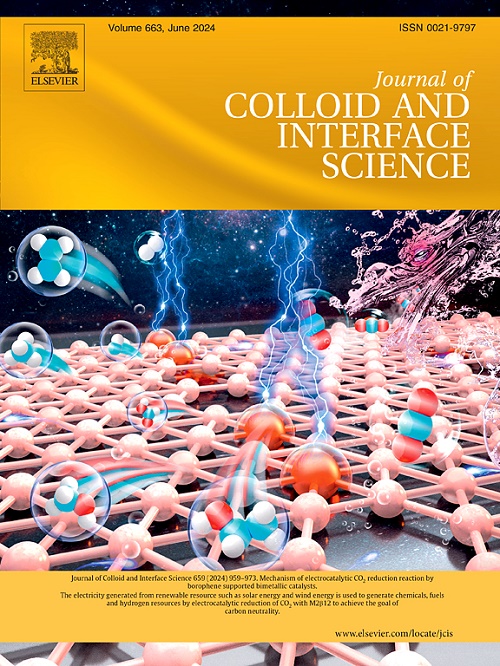pH-activated metal–organic layer nanozyme for ferroptosis tumor therapy
IF 9.4
1区 化学
Q1 CHEMISTRY, PHYSICAL
引用次数: 0
Abstract
Nanozymes have made great achievements in the research of tumor therapy. However, due to the complex tumor microenvironment, the catalytic activity and biosafety of nanozymes are limited. High catalytic efficiency is a relentless pursuit for the preparation of high-performance nanozymes. Dimensional reduction from 3D nanoscale metal–organic frameworks (nMOFs) to 2D nanoscale metal–organic layers (nMOLs) increases the encounters frequency of nanozymes and substrate, which facilitates the diffusion of reactive oxygen species (ROS) from nMOLs, thus significantly improving the effectiveness of chemodynamic therapy. In this study, He@Ce-BTC nMOF and He@Ce-BTB nMOL based on Ce6 SBUs were synthesized by solvothermal reaction. Compared with the 3D nMOFs, the 2D nanozymes He@Ce-BTB nMOL possessed enhanced ROS catalytic efficiency, were able to be activated by the tumor acidic microenvironment with the polymerase mimetic activities (CAT, POD, GSH-OXD) that enhances the lipid peroxidation process and accelerates the process of ferroptosis thereby killing tumor cells. In addition, He@Ce-BTB does not affect normal tissue cells, thus avoiding diffusion-induced side effects. He@Ce-BTB has shown excellent therapeutic effects in vitro and in vivo, which indicates its potential for clinical application, and is expected to become a new generation of drugs for the treatment of tumors.

用于治疗肿瘤的 pH 活化金属有机层纳米酶。
纳米酶在肿瘤治疗研究中取得了巨大成就。然而,由于肿瘤微环境复杂,纳米酶的催化活性和生物安全性受到限制。高催化效率是制备高性能纳米酶的不懈追求。从三维纳米级金属有机框架(nMOFs)降维到二维纳米级金属有机层(nMOLs),增加了纳米酶与底物的相遇频率,有利于活性氧(ROS)从nMOLs中扩散,从而显著提高化学动力学治疗的效果。本研究通过溶热反应合成了基于 Ce6 SBUs 的 He@Ce-BTC nMOF 和 He@Ce-BTB nMOL。与三维 nMOFs 相比,二维纳米分子 He@Ce-BTB nMOL 具有更高的 ROS 催化效率,能被肿瘤酸性微环境激活,具有模拟聚合酶(CAT、POD、GSH-OXD)的活性,能增强脂质过氧化过程,加速铁氧化过程,从而杀死肿瘤细胞。此外,He@Ce-BTB 不会影响正常组织细胞,从而避免了扩散引起的副作用。He@Ce-BTB 在体外和体内均显示出良好的治疗效果,表明其具有临床应用潜力,有望成为治疗肿瘤的新一代药物。
本文章由计算机程序翻译,如有差异,请以英文原文为准。
求助全文
约1分钟内获得全文
求助全文
来源期刊
CiteScore
16.10
自引率
7.10%
发文量
2568
审稿时长
2 months
期刊介绍:
The Journal of Colloid and Interface Science publishes original research findings on the fundamental principles of colloid and interface science, as well as innovative applications in various fields. The criteria for publication include impact, quality, novelty, and originality.
Emphasis:
The journal emphasizes fundamental scientific innovation within the following categories:
A.Colloidal Materials and Nanomaterials
B.Soft Colloidal and Self-Assembly Systems
C.Adsorption, Catalysis, and Electrochemistry
D.Interfacial Processes, Capillarity, and Wetting
E.Biomaterials and Nanomedicine
F.Energy Conversion and Storage, and Environmental Technologies

 求助内容:
求助内容: 应助结果提醒方式:
应助结果提醒方式:


